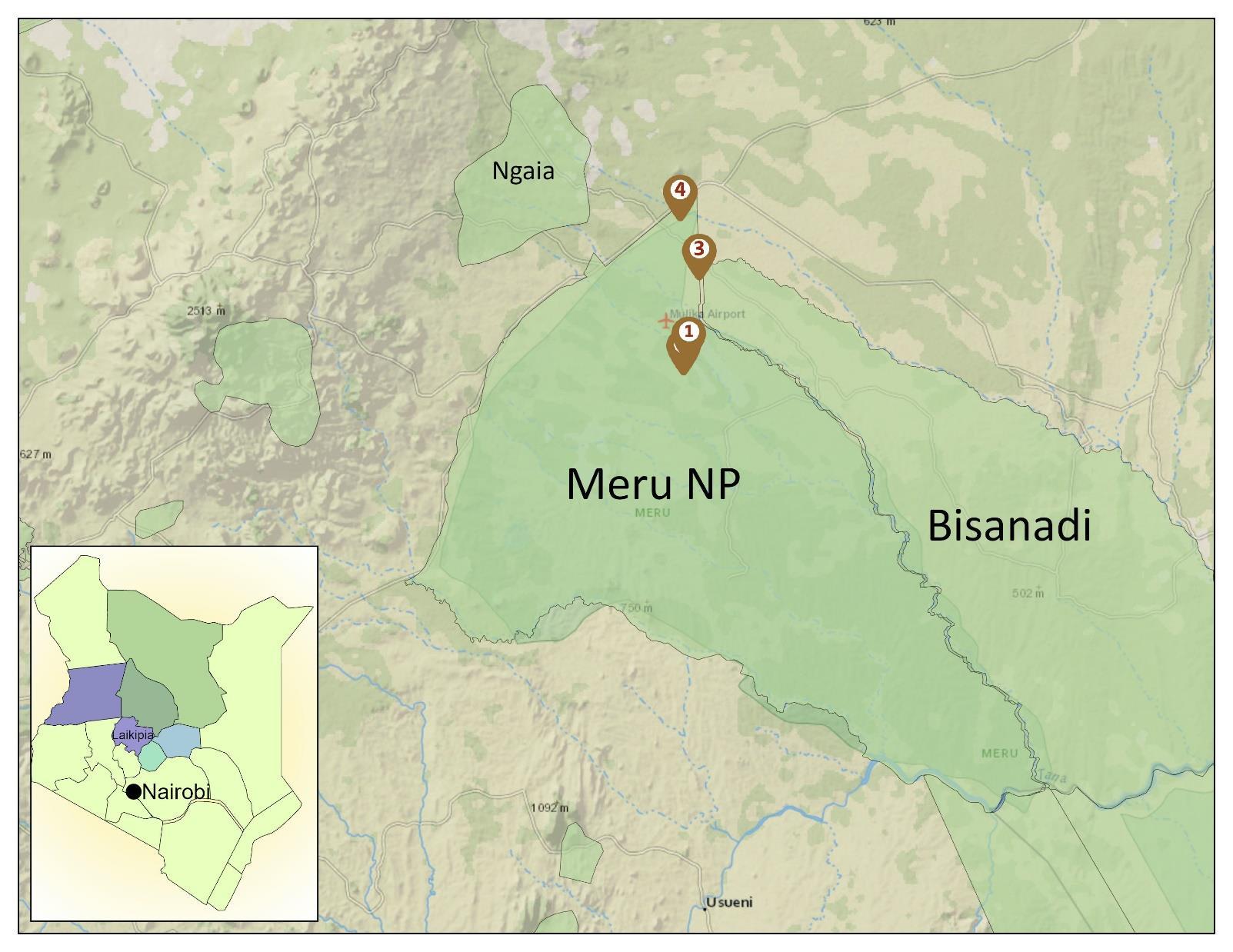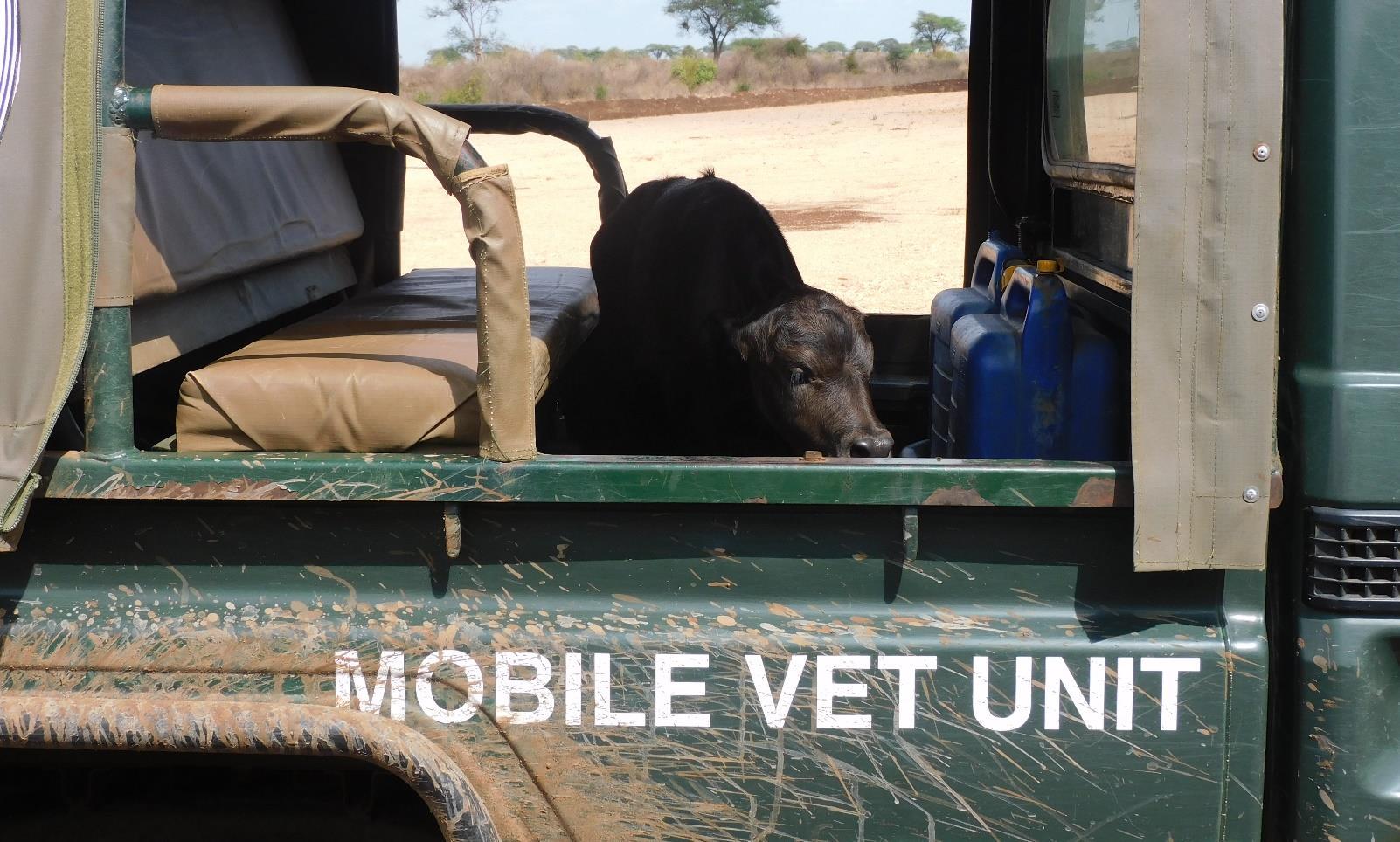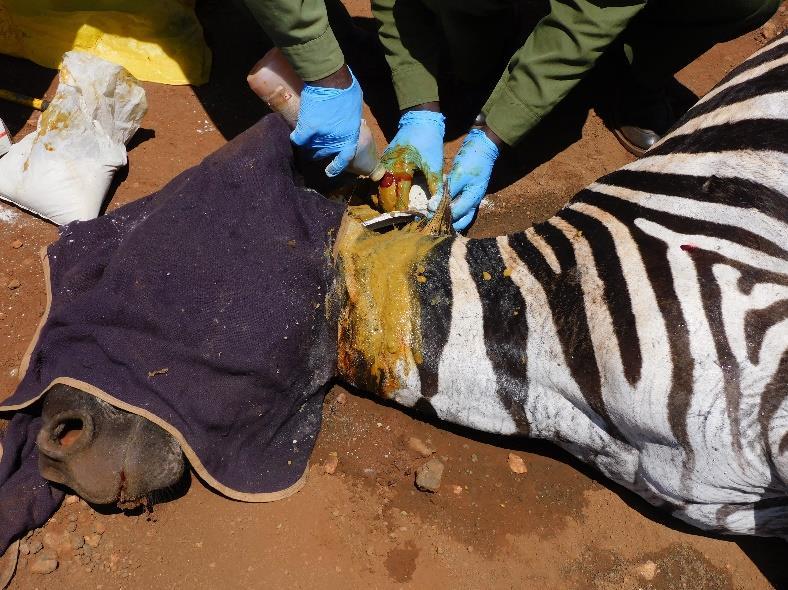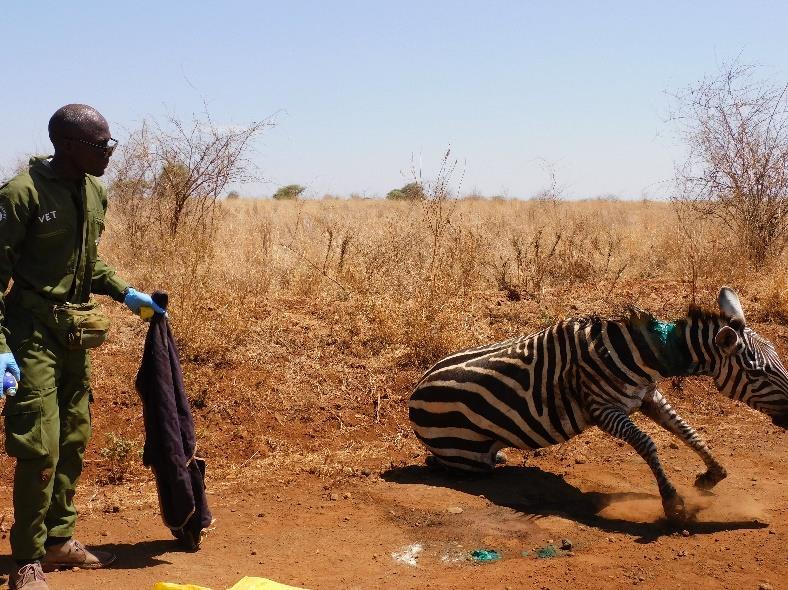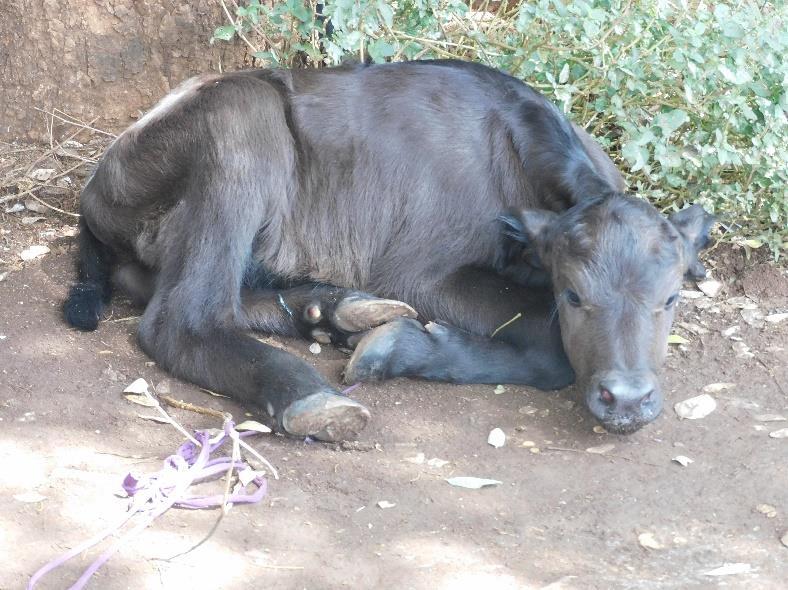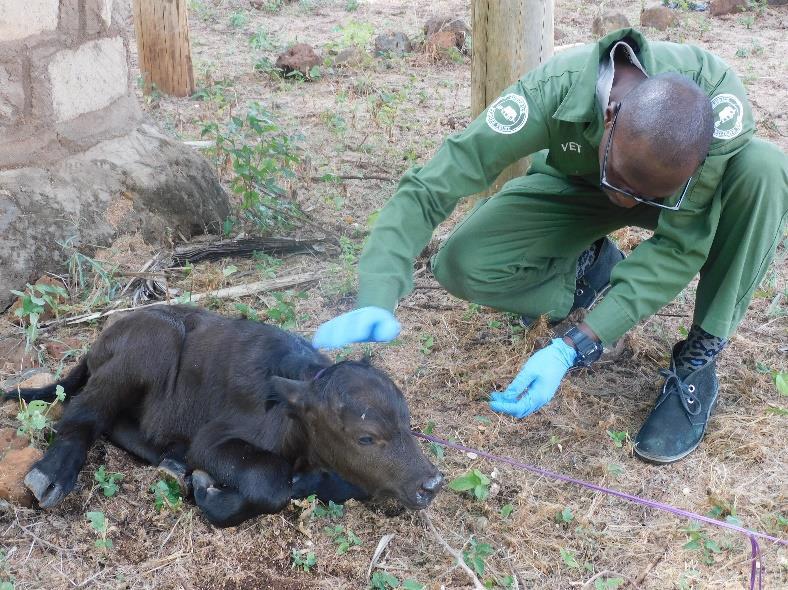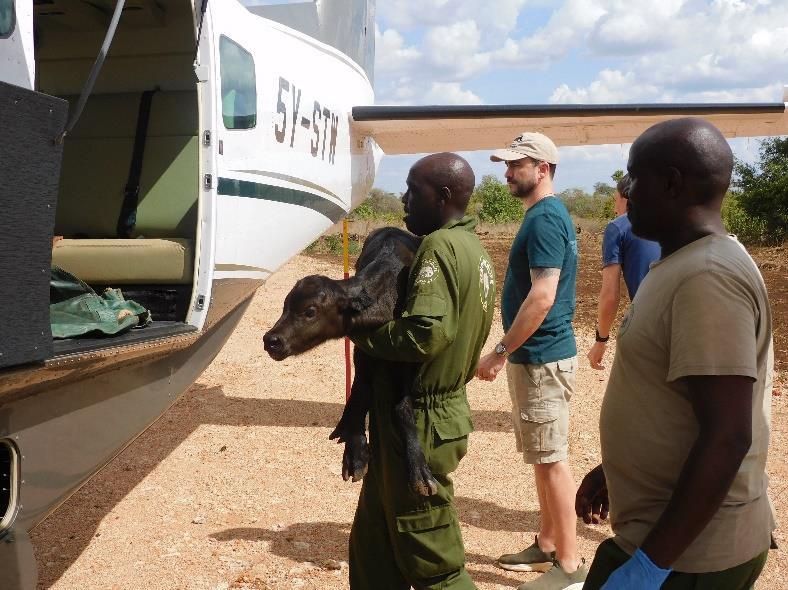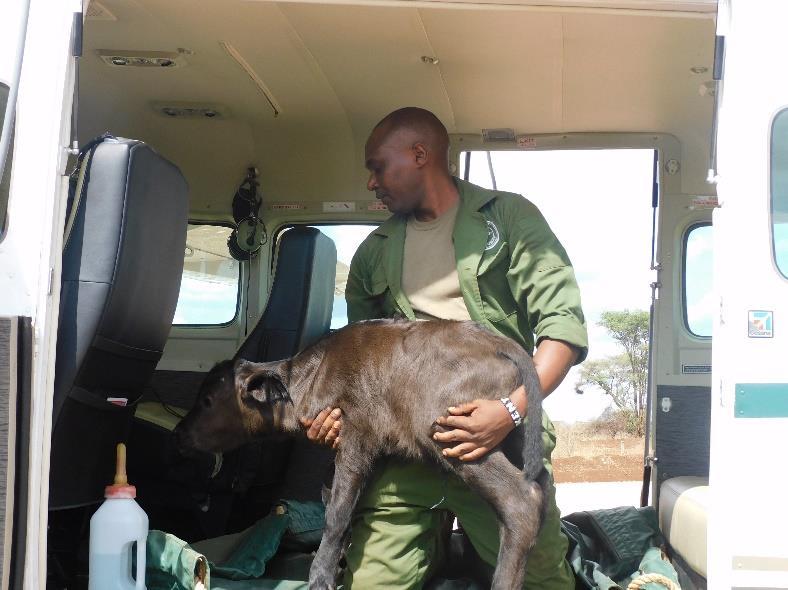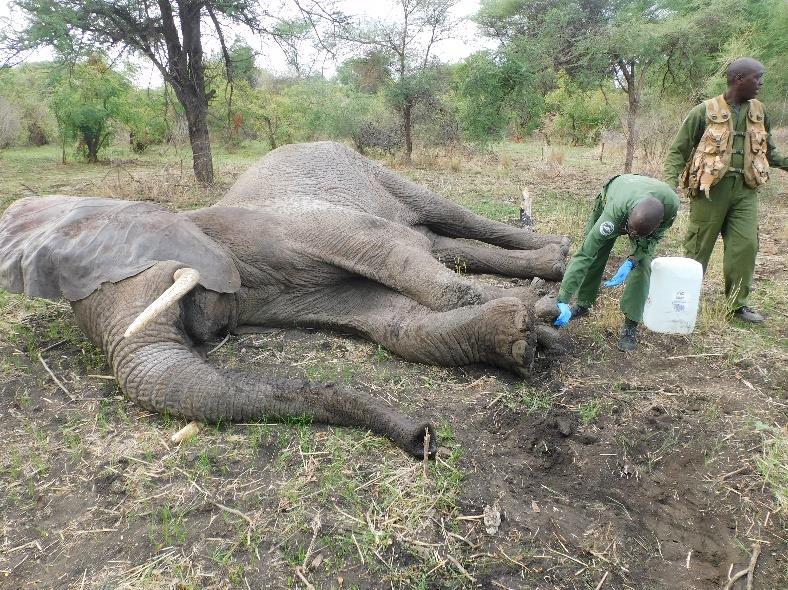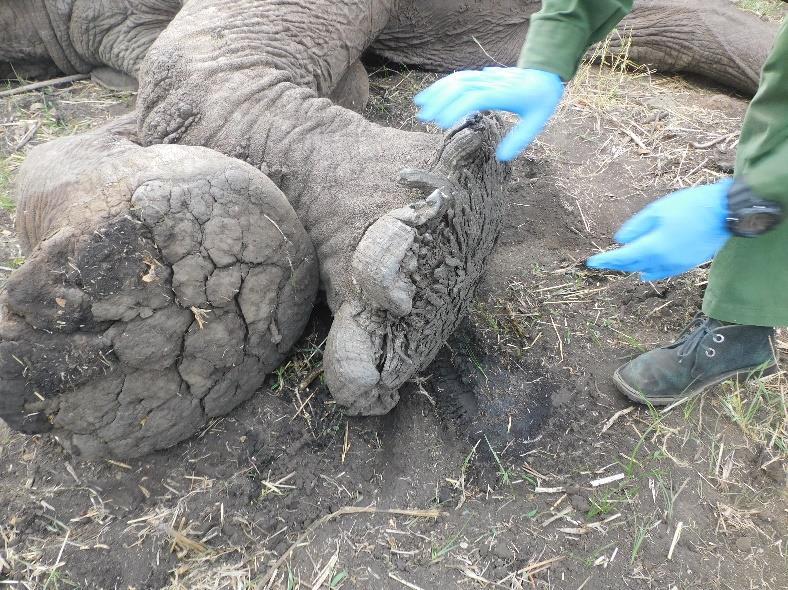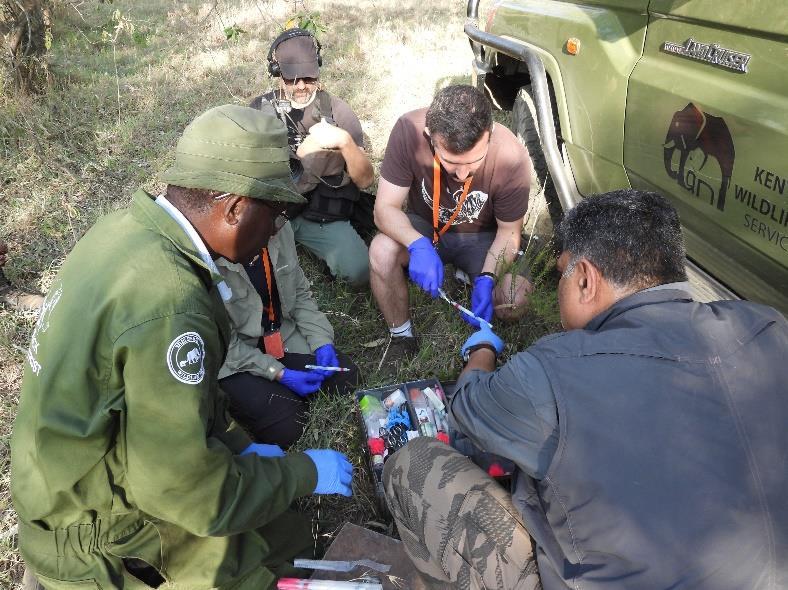SWT/KWS MERU MOBILE VETERINARY UNIT
MARCH 2025
4 Cases in March 2025
March Report by Dr.
Aminga Duncan
2 Poaching Cases
1 Elephant Case
March signalled the onset of the rainy season in the Meru ecosystem. Heavy clouds began forming in the skies, accompanied by strong, chilly winds at night and intense daytime heat. As the month progressed, the first showers arrived; seasonal rivers, once mere memories, awakened with a trickle while the permanent rivers slowly swelled with newfound pride. A green symphony unfolded, carpets of fresh shoots and blossoms painting the land in nature’s vibrant hues. We remain hopeful that the continued rainfall will sustain adequate forage and water for wildlife in the coming months.
During this period, the SWT/KWS Meru Mobile Veterinary Unit responded to four wildlife cases, two of which were snare-related injuries. The team rescued a one-day-old male buffalo calf in Bisanadi National Reserve and treated a female plains zebra and a sub-adult reticulated giraffe bull in Meru National Park, both of which had wire snares. All three animals had a good prognosis for recovery. The team also treated an elephant bull suffering from lameness due to an overgrown sole and cracked toenail. Unfortunately, the prognosis for recovery remains poor.
Additionally, the veterinarian attended the 2025 Interventions for Wildlife Animal Health Course, organized by the Wildlife Health Bridge consortium, held at WRTI Naivasha, Kenya.
Acknowledgement
We are deeply thankful to Sylvie Chantecaille and the Sheldrick Wildlife Trust for their steadfast commitment to supporting the Meru Mobile Veterinary Unit. Their funding is a cornerstone of efforts to safeguard the health and survival of wildlife in the Meru ecosystem. Equally, we appreciate the Kenya Wildlife Service for their outstanding leadership and coordination. The guidance of the KWS Head of Veterinary Services and the Senior Assistant Director of the Eastern Conservation Area has been vital in driving the success of conservation initiatives and ensuring the well-being of wildlife.
Case Details
March 2025
Case 1 – 14th March 2025
Zebra
Snared
Meru National Park
In January the Unit encountered two zebras with snares around their necks. One zebra was successfully treated, however, attempts to assist the second zebra were unsuccessful, as she remained in dense, rocky terrain, making intervention extremely difficult. Despite multiple subsequent efforts, she evaded treatment by seeking refuge in thick vegetation within challenging terrain. Several weeks later, the vet team spotted her again in a rugged, rocky area. This time, they were determined to ensure she received the medical attention she needed no matter the challenge.
Immobilisation, examination and treatment
She displayed skittish behaviour when approached by the vehicle. After a brief chase, she was successfully immobilised with 5mgs Etorphine and 80mgs Azaperone. The wire snare around her neck had inflicted significant muscular trauma, though the cervical vertebrae remained structurally intact. The snare was carefully removed, and the wound was thoroughly cleaned with water before being debrided with Hydrogen peroxide. To promote healing, the wound was flushed with Iodine, packed with green clay for its therapeutic properties, and covered with an antibiotic aerosol to prevent fly infestation A rectal examination was done to check if she was pregnant. She was administered 120 mgs of Dexamethasone sodium intramuscularly to manage inflammation and 9,000 mgs of Amoxicillin for prophylactic bacterial infection control
Prognosis
The anaesthetic was reversed and she swiftly retreated into her natural habitat, with a good prognosis for recovery.
Giraffe Snared
Meru National Park
The Meru Vet Unit received an urgent report from the KWS Meru Platoon team about a sub-adult reticulated giraffe bull spotted with a wire snare near the hoof of its left hind limb during their routine park patrol. Immobilisation, examination and treatment
Upon arrival, the veterinary team conducted a physiological assessment and following a brief discussion on the intervention plan, the veterinarian prepared a dart containing 12mgs Etorphine and 30mgs Azaperone. The giraffe was wary and easily startled when the vehicle approached necessitating a short chase. The dart was successfully delivered into the left thigh muscles, and after approximately 10 minutes, the immobilizing agents took effect. The giraffe was then expertly roped to the ground, with its neck and head secured to allow for a comprehensive clinical examination.
The examination confirmed that a wire snare was tightly wrapped around the giraffe’s left hind limb, just above the hoof. Fortunately, there were no significant injuries, so further treatment wasn’t required. The snare was carefully removed, and minor abrasions were disinfected with an antibiotic spray.
Reversal and prognosis
To reverse the anaesthesia, 200mgs of Naltrexone was administered via the jugular vein. Within two minutes, the giraffe regained consciousness, stood up, and trotted off with a good prognosis for full recovery.
Buffalo Rescue
Meru National Park
The Meru Vet Unit received a report from KWS Rangers about a young male buffalo calf found abandoned and alone in the Bisanadi area. No buffalo herds were sighted nearby, and despite extensive efforts, the rangers were unable to locate its maternal herd. Given the calf’s vulnerability, they decided to rescue it and take it to their camp while calling in the veterinary team for assessment and further intervention.
Rescue
On arrival, the vet team found the calf resting in a shaded area within the rangers' camp. He was alert and active. A physical examination revealed a smooth, shiny coat, pink and well-moisturized mucous membranes, and no signs of limb injuries or fractures. His umbilical cord was still fresh, indicating he was only a few hours old. However, he appeared fairly hydrated, suggesting he may have suckled before being abandoned. The umbilical cord and navel were immediately disinfected with Iodine. His body temperature and respiratory rate were slightly elevated, likely due to the intense heat. He was given an oral rehydration solution and fresh milk. Additionally, his body was cooled by rubbing him with a moist cloth, which helped stabilize him.
Given the calf's age, the absence of a maternal herd nearby, and its inability to survive independently in the wild, the decision was made to transfer it to the SWT orphan nursery for specialized care and eventual rehabilitation. SWT arranged for a plane to airlift the calf from Meru National Park to Kaluku. We're optimistic about its recovery and believe it will thrive, eventually finding its place in the Kenyan savannah.
Elephant Natural Causes
Meru Environs
Over the past few weeks, the Meru Vet Unit received multiple distress reports from community members in the KinnaMeru area regarding an adult elephant exhibiting lameness, characterized by abnormal growths and mild weightbearing difficulty on its left forelimb. Efforts to conduct a thorough clinical assessment had been unsuccessful, as the elephant frequently sought refuge in rugged, rocky terrain with dense vegetation, rendering access by vehicle impossible. However, on 24/03/2025, the elephant was sighted again within community settlements. The veterinary team with support from the SWT Meru Rhino sanctuary fence maintenance team promptly responded.
Immobilisation, examination and treatment
The elephant was approached using a vehicle and immobilized with 15mgs Etorphine. The pharmacological effects manifested rapidly, and within 10 minutes, the animal assumed sternal recumbency. To prevent respiratory compromise due to thoracic pressure, the elephant was promptly repositioned onto its side.
Upon clinical examination, the elephant was found with excessive overgrowth of the toes, measuring approximately 4 inches from the base of the foot, along with an overgrown and indurated sole. The individual was positively identified as having undergone treatment in July 2023 within Meru National Park for the same condition, during which the overgrown tissues were surgically trimmed. However, despite the intervention, minimal improvement was observed, as the toes remain overgrown and the sole continued to exhibit abnormal thickening and increased hardness relative to the other limbs. Further examination revealed a foreign body; a small wooden fragment, deeply embedded within the sole, causing pain and discomfort. The fragment was carefully extracted, and the wound was disinfected with an antibiotic spray. Additionally, the elephant was administered an intramuscular injection of 2,000mgs Flunixin for analgesia and anti-inflammatory effects, along with metabolic stimulators to support recovery.
Despite prior intervention, the hypertrophic growth of the toes and sole has shown minimal improvement. This may be attributed to the terrain of his habitat, which is predominantly rocky with loose gravel and uneven surfaces, potentially exacerbating the condition. Nevertheless, the bull was observed to be in fair body condition and appeared to have adapted to living with the deformity.
Prognosis
The animal regained consciousness within two minutes of reversing the anaesthetic and walked away without immediate complications. Regrettably, the prognosis for full recovery remains poor.
Attendance of the 2025 Interventions for WildlifeAnimal Health (IWAH) International
Course in WRTI HQs, Naivasha
The Interventions in Wild Animal Health (IWAH) Course 2025 provided a unique opportunity to engage in an intensive, hands-on training program focused on wildlife health and management. Hosted at the Wildlife Research and Training Institute (WRTI) Campus in Naivasha, Kenya, with practical field sessions in Hell’s Gate National Park, the course was organized by a collaboration of leading institutions, including Zoological Society of London (ZSL), Toronto Zoo, Wildlife Institute of India (WII), Kenya Wildlife Service (KWS), Royal Veterinary College (RVC), University of Melbourne (UoM), and the University of Edinburgh.


The training covered a broad spectrum of essential topics, with a strong emphasis on wildlife immobilization, both physical and chemical restraint techniques. Participants explored advancements in anaesthetic drug protocols, field anaesthesia monitoring, and the latest research in wildlife medicine. Practical sessions in Hell’s Gate National Park provided an opportunity to apply these theoretical concepts, allowing participants to immobilize various wild herbivores under real field conditions.
This course was an invaluable experience, offering not only technical skills but also a platform for collaboration among wildlife health professionals from diverse backgrounds.






